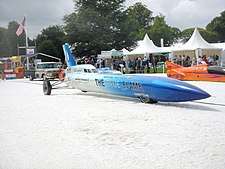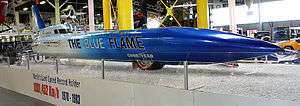Blue Flame
Blue Flame is a rocket-powered land speed racing vehicle that was driven by Gary Gabelich and achieved the world land speed record on Bonneville Salt Flats in Utah on October 23, 1970. The vehicle set the FIA world record for the flying mile at 622.407 mph (1,001.667 km/h) and the flying kilometer at 630.388 mph (1,014.511 km/h).[1]


Design and construction
Blue Flame was constructed in Milwaukee, Wisconsin by Reaction Dynamics, a company formed by Pete Farnsworth, Ray Dausman and Dick Keller, who had developed the first hydrogen peroxide rocket dragster,[2] called the X-1 and driven by Chuck Suba.[3] The car used a combination of high-test peroxide and liquified natural gas (LNG), pressurized by helium gas.[4] The effort was sponsored by the American Gas Association, with technical assistance from the Institute of Gas Technology of Des Plaines, IL.[5] [6]
The engine was designed by Reaction Dynamics and some of the components were manufactured by Galaxy Manufacturing of Tonawanda, New York.
Blue Flame's engine is a regeneratively cooled variable thrust liquid-propellent engine. It can operate on either a single- or dual-propellant basis. In operation, it permits natural gas use as a liquid, gas, or both with a two-stage combustion start. The oxidizer flow is established first, then LNG enters a heat exchanger where it vaporizes and is brought to combustion temperature. The gas is then injected into the combustion chamber with the oxygen provided by the hydrogen peroxide. A stable flame front is established and the remaining liquified natural gas (LNG) is injected to bring the engine to full power.[7]
Nominal engine running time was 20 seconds at full thrust of 22,500 lbf (100 kN), the equivalent of 58,000 hp (43 MW).[8] [9] Keller stated the Goodyear Tire Company restricted their top speed to 700 mph (1,100 km/h). Reaction Dynamics subsequently modified the LNG flow in the two-stage injector system to almost halve the maximum thrust.[10] The actual thrust during the record runs was between 13,000 lbf (58 kN) [equivalent of 35,000 hp (26 MW)][11] and 15,000 lbf (67 kN). Blue Flame's record runs involved accelerating continuously to the mile midpoint, then coasting through the mile. The peak speed, approximately 650 mph (1,050 km/h), was reached at that point and then the vehicle decelerated the rest of the way. The kilometer speed trap was biased towards one end of the mile, resulting in the 8 mph (12.9 km/h) higher speed.
Blue Flame uses an aluminum semi-monocoque with welded tubular structure in the nose section and an aluminum "skin." The vehicle is 37 ft 4.6 in (11.394 m) long, 8 ft 1.5 in (2.477 m) high to the top of the tail fin, and 7 ft 8 in (2.34 m) wide, with a wheelbase of 306 in (7.8 m). It has an empty weight of 4,000 lb (1,800 kg) and is approximately 6,600 lb (3,000 kg) fully fueled and loaded.[12] Goodyear Tire and Rubber Co. designed 8:00-25 tires for the vehicle, with an outside diameter of 34.8 in (880 mm) and smooth tread surface to help prevent heat buildup, filled with nitrogen gas at 350 psi (24 bar).[13]
Land speed record
On 23 October 1970 at Bonneville, Gary Gabelich drove Blue Flame to a new record of 622.407 mph (1,001.667 km/h) for the flying mile, 630.388 mph (1,014.511 km/h) for the flying kilometre.[14][15]
Legacy
Blue Flame is now on permanent exhibition at the Auto and Technik Museum Sinsheim in Germany.[16]
See also
References
- "Archived copy". Archived from the original on 2013-10-19. Retrieved 2013-10-09.CS1 maint: archived copy as title (link)
- "1970: Blue Flame driven by Gary Gabelich". ©Copyright 1999-2014 Unique Cars & Parts.
- Ratliff, Franklin. "Drag Racing Story of the Day - Early History of the Hydrogen Peroxide Rocket Dragster". Draglist.com Copyright 1996-2014 by Bilden Enterprises.
- Coonce, Cole. "IT WASN'T FOR NOTHING THAT WE DID IT - Transcript of interview with Pete Farnsworth". INFINITY OVER ZERO Blog at WordPress.com.
- "The Blue Flame Record Car". Text: Charles Armstrong-Wilson Photos: Richard Keller/American gas association.
- "DICK KELLER - SPACE AGE SPEEDSTER". Cling on for dear life Blog on Blogspot.co.uk Monday, 30 April 2012.
- "Blue Flame - Land Speed Racing History". Copyright © 2012 Hot Rods Down Under.
- "Featured Stories > Rocket Science - The Blue Flame Record Car". © 2014 AutoTraderClassics.com, Inc.
- Wells, Bruce A. "The Blue Flame – Natural Gas Rocket Car". American Oil & Gas Historical Society, 2014.
- Keller, Richard. "True Blue Natural Gas - An Energy Blog from the American Gas Association AGA". American Gas Association.
- "ThrustSSC - History - The Blue Flame". © SSC Programme Ltd, 1997.
- "ThrustSSC - History - The Blue Flame". © SSC Programme Ltd, 1997.
- Coonce, Cole. "THE OTHER X-1 - Transcript of interview with Pete & Leah Farnsworth". INFINITY OVER ZERO Blog at WordPress.com November 3, 2008.
- Holthusen, Peter J.R. (1986). "Appendix 1: Land speed records". The Land Speed Record. Guild Publishing. p. 203.CS1 maint: ref=harv (link)
- Joel. "The Blue Flame: Sun, Salt, and Speed | Today's History Lesson". Blog at WordPress.com.
- "The Blue Flame". Auto & Technik MUSEUM SINSHEIM Museumsplatz D-74889 Sinsheim Germany. Archived from the original on 2013-10-16.
External links
Further reading
| Wikimedia Commons has media related to Blue Flame. |
- Michaelson, Ky (2007). Rocketman: My Rocket-Propelled Life and High-Octane Creations. Motorbooks Intl. ISBN 978-0-7603-3143-9.